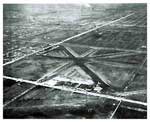
Midway Airport: Crossroads of the World
During the 1930's, 40's and 50's, it was the world's
busiest airport, at a time when air travel was a rare and thrilling
event. Prior to O'Hare's arrival on the scene, 75-year-old Midway Airport
was Chicago's aerial theater -- exciting, glamorous and challenging.
It originally opened as Chicago Municipal Airport on May 8, 1926. Almost immediately,
it became a popular attraction as people flocked to watch the planes take off
and land.
 One
symbol of the airport's glamour was The Cloud Room, the popular
restaurant located in the terminal and operated by Marshall Field & Company.
Diners enjoyed their meals, and the floor-to-ceiling windows provided
picturesque views of the field and the airplanes.
One
symbol of the airport's glamour was The Cloud Room, the popular
restaurant located in the terminal and operated by Marshall Field & Company.
Diners enjoyed their meals, and the floor-to-ceiling windows provided
picturesque views of the field and the airplanes.
No one, however, had a better view of Midway's activities than the students at
Nathan Hale School, whose building sat barely 100 yards from two of the runways.
When planes took off and landed, "the entire building would vibrate," remembers
Robert Hill, a former student at Nathan Hale. Eventually, due to safety concerns,
those two runways were closed when school was in session.
Eventually, with the advent of jumbo jets (which Midway's short runways could
not accommodate) and the opening of O'Hare, Midway fell on hard times. As transportation
author David Young explains, "The airlines didn't want to pay for two sets
of facilities, one at Midway and one at O'Hare. So in the early sixties, there
was a stampede to O'Hare once the airport was fully completed." Private planes
still used Midway, but over the next 17 years, the commercial airlines operations
slowed and even stopped for a time.
 In the late 1970's, however, new federal regulations that deregulated the airline
industry would inspire Midway's renaissance. Professor Perry Duis of the University
of Illinois, Chicago, remembers, "They opened up routes that had been reserved
for only a few carriers, and allowed airlines to reduce fares." This opened
the door for new deregulated carriers such as Midway Airlines, which breathed
life back into the airport.
In the late 1970's, however, new federal regulations that deregulated the airline
industry would inspire Midway's renaissance. Professor Perry Duis of the University
of Illinois, Chicago, remembers, "They opened up routes that had been reserved
for only a few carriers, and allowed airlines to reduce fares." This opened
the door for new deregulated carriers such as Midway Airlines, which breathed
life back into the airport.
Today, Midway has grown to include eight budget carriers. Major airlines, including
American and Northwest, operate there as well. And the city of Chicago is in
the midst of a 722 million-dollar renovation project. While the battles continue
to expand O'Hare or build a third airport, Midway's health remains robust.
Midway
Memories
Midway's engaging story was told through interviews with area
residents, former pilots and flight attendants, airport employees
and local historians who shared
their personal memories, recapturing much of the innocence and charm that characterized
the airport in its heyday.
Here are further reminiscences from some of the people who were interviewed for
the program:

Links
of Interest
Smithsonian National Air and Space
Museum
The museum is celebrating its first quarter-century.
Landings
"The Busiest Aviation Hub in Cyberspace"
John
Callaway's Midway Musings
Yes, it was thrilling watching the planes arrive and depart at Midway in its
l950's heydays, but very often it was a great big pain in the neck getting to
dear old Midway. I can remember how excited I was when I took my young wife and
our one-year-old daughter, Ann Hampton, on our first flight out of Midway. We
were headed to Pittsburgh, where my Dad would meet us and drive us back home
to West Virginia. We didn't own a car in those days (l959) and so we hailed a
cab not far from where we lived in the old Town and Garden Apartments in the
1400 block of North Hudson. You have to remember that this was pre-expressway
Chicago. I had not allotted enough time for the trip to Midway. The cab driver
made reasonably good time until we hit Ogden. The diagonal journey southwest
on Ogden Avenue toward Cicero Avenue was faster than walking, but not much. It
was bumper to bumper all the way on Ogden and then, of course, when we arrived
at Cicero Avenue we encountered even heavier traffic, this time the usual endless,
highly toxic parade of trucks. By the time we arrived, the thrill of anticipation
of flying had been dampened by the stress and fatigue of a miserably memorable
cab ride. Only because of delays caused by bad weather were we able to make our
flight to Pittsburgh. An ironic note: in recent years, when travel to or from
Midway would be complicated by construction on the Stevenson Expressway, I often
found Ogden Avenue a wonderful alternative route back to the center of the city!
But my most memorable moments at Midway occurred on my very first day as a reporter
for CBS in Chicago -- the old combined radio and television news operation of
WBBM. It was March 11, 1957. My first assignment was a tough one. The desk told
me to take a camera crew and go out to Midway where I was to try to interview
the then Attorney General of the United States, William P. Rogers (later Secretary
of State in the Nixon administration). My assignment was to intercept Mr. Rogers
as he deplaned at Midway and ask him questions on camera about the Justice Department's
latest investigation into the Teamsters Union.
Because the interview had not been cleared in advance with the Justice Department,
and because the Attorney General wouldn't know me from Adam, I was sure that
my colleagues back in the newsroom had very little expectation that I actually
would be able to record the interview. I shared their skepticism. I was sure
the Attorney General would walk right past me and my camera crew. Well, surprise,
surprise. Not only did Attorney General Rogers stop when I greeted him coming
off the plane, he took the time to answer every one of my questions! And my camera
crew captured the entire interview on film. Overjoyed, I quickly gave the film
to the courier who rushed back to the lab near CBS to have it processed for use
in that night's Fahey Flynn l0 p.m. news.
In those days, once a reporter had finished his filming of an interview, he then
was expected to call into the news desk at CBS and tell them details of the story
which would then be written up and given to staff announcers to read on WBBM
Radio. That seems too quaint today but that's what the procedure was back then.
So I called the desk and I got the crusty old bureau chief, Mike Neigoff. I could
hear the skepticism in his voice when he asked, "Did you get the interview?"
And I said, "Yes, sir! And he answered every one of my questions. And the film
is on the way in with the courier."
And so Neigoff replied, "That's great kid! Congratulations! What did the Attorney
General say?"
And I said, after one of the most painful pauses of my life, "I don't know, sir.
I don't have a clue as to anything he said."
The problem was, of course, that I was puffed up being all dressed up and accompanied
by a CBS camera crew. I was representing the House of Edward R. Murrow. I was
a Big Shot Reporter for CBS. I couldn't be bothered to actually listen to the
Attorney General's answers.
I remember Neigoff then asking me, "Kid, what did you learn from this experience?"
I replied, "I guess I learned that you have to listen."
"That's right, kid. You can come on in."
So it was at Midway Airport in l957 that I learned the hard way the most important
lesson a reporter and interviewer can learn -- when you ask a question, you'd
better be prepared to listen, really listen, to the answer. Thank you and good
night.
About
the Program Producer
In addition to Midway Airport: Crossroads of the World for Chicago Stories,
Kathleen Quinn has written and produced documentaries which have aired on A&E
and The History Channel. In 1998, her A&E program on heroism was awarded a silver
medal from the New York Festival.
We asked Kathleen to comment on what she'd learned during the
making of this Midway documentary:
 Many people admire Midway Airport's shiny new terminal building and see glimpses
of the future. When shooting footage at the airport for this show, my eye was
drawn to the old terminal and I was transported to the past. The vivid descriptions
that Chicagoans shared about the airport made me wish that I had witnessed them.
From its earliest days, Midway dazzled the senses -- from the whiff of aviation
fuel to the blasts of hot wind sprayed from propellers, from the roar of aircrafts' engines
to the 'oohs' and 'ahhs' from the mesmerized crowds.
Many people admire Midway Airport's shiny new terminal building and see glimpses
of the future. When shooting footage at the airport for this show, my eye was
drawn to the old terminal and I was transported to the past. The vivid descriptions
that Chicagoans shared about the airport made me wish that I had witnessed them.
From its earliest days, Midway dazzled the senses -- from the whiff of aviation
fuel to the blasts of hot wind sprayed from propellers, from the roar of aircrafts' engines
to the 'oohs' and 'ahhs' from the mesmerized crowds.
But while images of Midway are seared in the minds of countless Chicagoans, the
airport also conjured myriad personal memories. Midway was where couples went
on their first date to watch the airplanes take off and land. A few of these
folks even sheepishly admitted some necking went on too! Children who grew up
on the southwest side made secret excursions to Midway on their bikes, despite
being forbidden by their parents. The allure of Midway was too great to resist.
They'd ride all around the square mile and stop along each side hoping to catch
a glimpse of pilots, planes and celebrities. Midway was a place but it was also
an event in and of itself.

Your $40 Gift Membership will include:
|
























































